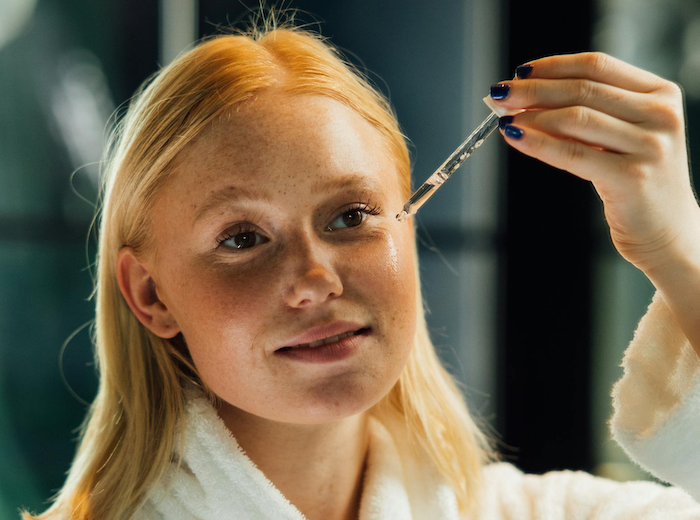Retinol irritations…they’re so annoying, right?
You want the benefits of retinol. You know it can help you achieve smoother, more youthful skin. But if you use it, you will experience redness, dryness, flaking, stinging and other irritations and side effects.
It’s so frustrating. You want the radiant complexion that retinol promises, but these irritations can make your skin look anything but radiant.
In this article, we explain why you may be experiencing some of the side effects and what you can do to reduce them while still getting the benefits of your retinol or retinoid.
What is retinol or retinoids?
Retinol is a derivative of vitamin A and a popular ingredient in anti-aging and acne treatments. It is part of a broader family of retinoids – a class of medications and skin care ingredients derived from vitamin A. These include topical retinoids that you apply directly to the skin – such as tretinoin, adapalene and retinol – and oral retinoids that you take in pill form. , such as isotretinoin.
Retinol is an over-the-counter option that converts in the skin to retinaldehyde and then to retinoic acid (the active form). This slower conversion process makes it gentler on the skin compared to prescription retinoids, which are already in active form and work more aggressively.
For example, prescription tretinoin is already in active form and is more likely to cause irritation. However, sensitive skin may still respond to the gentler retinol form.
Retinol accelerates cell turnover, helping to remove dead skin cells and reveal fresher, smoother skin. It also stimulates collagen production, which helps reduce the appearance of fine lines and wrinkles, fades hyperpigmentation and improves skin texture.
Retinol is also used to treat acne and related scars, but severe acne is usually treated with a stronger prescription retinoid and other medications.
Common retinol irritations and why they happen
Although retinol is a gentler version of retinoid, it can still cause irritation and other side effects in many people, even those with only mildly sensitive skin.
Common problems include:
- Dryness and peeling: Because retinol accelerates cell turnover, the top layer of skin can become dry and flaky.
- Redness and irritation: Retinol can damage the skin’s barrier, leading to inflammation and redness.
- Increased sensitivity: The skin can react more strongly to aggressive external influences, such as sunlight or aggressive products.
- Retinol burns: Some people may experience more intense irritation from retinol that resembles a sunburn, complete with redness, stinging and sensitivity.
You may experience these types of effects more often than others depending on your skin type, sensitivity, and the type of retinol you use.
Control retinol irritations without losing the benefits
Try these seven steps to control irritation, dryness, and flaking and increase the benefits of your retinol and retinoid treatment.
1. Start slow and low
When you start using retinol (or restart it after a break), start with a lower concentration, such as 0.25 percent or 0.3 percent. Then use it only once or twice a week. Give your skin time to get used to the treatment. Over time, you can gradually increase the frequency as your skin learns to tolerate it.
2. Moisturize generously
Hydration is key to minimizing the drying effects of retinol. Apply a rich, soothing moisturizer, such as our CV Skinlabs Calming Moisture, after using retinol or retinoid. Dermatologists regularly recommend it to soothe any irritation or inflammation while strengthening your skin’s natural barrier. Antioxidant-rich and natural ingredients like plant-based ceramides and non-comedogenic emollients help keep skin hydrated and free from flaking, and will also tame redness and help your skin recover quickly.
3. Use the “Sandwich Method”
If you still experience irritation, try the ‘sandwich method’. First apply a layer of Calming Moisture and then apply your retinol product. After this has dried, apply another layer of Calming Moisture.
This technique reduces the chance of irritation by strengthening the skin barrier before and after applying retinol, ensuring you still get the benefits without the side effects, restoring clear, smooth and radiant skin.
4. Add soothing ingredients
Make sure you don’t use other products in your skin care or makeup routine that contribute to irritation. Check the ingredients and make sure your products don’t contain any of our avoidable ingredients. Then add more products with soothing and anti-inflammatory ingredients to your routine.
For example, our Rescue + Relief Spray is an excellent option to soothe irritation, add a boost of moisture, and cool sensitive areas. It’s also non-comedogenic, so a good choice for acne-prone skin. Daily use can help your skin adapt.
5. Protect your skin from the sun
Retinol can make your skin more susceptible to damage from ultraviolet (UV) rays, so it is a must to use sunscreen daily while using retinol. Choose a broad-spectrum product with an SPF of 30 or higher, preferably with zinc oxide or titanium dioxide as the main ingredient. Reapply as needed throughout the day, especially if you spend time outdoors.
6. Adjust your routine during flare-ups
If you experience significant irritation, reduce your retinol use. Skip a day or two and focus on rebuilding your skin barrier with gentle, nourishing care. Use a gentle, creamy cleanser, then apply our Rescue + Relief Spray as a toner and then apply our Calming Moisture to tame inflammation and redness and promote healing.
7. Listen to your skin
Every skin type is unique. Pay attention to how your skin reacts and adjust your routine regularly. If one product or approach doesn’t work, try another. Sometimes it takes several adjustments before you discover what works for you, so try not to get discouraged too quickly.

Retinol irritations: try variations and alternatives
If you’ve tried everything and your skin still reacts to your retinol product, you can use a gentler retinoid form.
Options include:
- Retinyl Palmitate: This is a milder, less irritating precursor to retinol.
- Bakuchiol: A plant-based alternative that mimics the effects of retinol without irritation.
- Encapsulated retinol: This delivery system allows retinol to penetrate the skin more slowly, reducing the chance of irritation.
The role of CV Skinlabs in managing retinol irritations
CV Skinlabs offers a range of products specifically designed to soothe and repair irritated skin, making them ideal companions for retinol users:
- Soothing moisture: Hydrates and soothes dry, irritated skin and strengthens the barrier.
- Rescue and relief spray: Provides instant cooling and soothing relief from redness and irritation.
- Repairing skin balm: A rich, healing balm that tackles peeling, dryness and sensitivity.
Retinol side effects can be frustrating, but they don’t have to stop you from enjoying healthier, brighter skin. Start slow, moisturize generously and incorporate products like CV Skinlabs into your routine to keep your skin comfortable and irritation-free.
How do you deal with retinol irritations?
Featured image by KoolShooters via Pexels.






